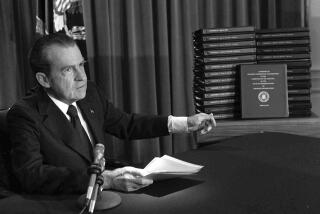Eureka! Experiments Could Be the Solution to Deadlock in Washington
- Share via
Newt Gingrich may have spent his summer vacation excavating dinosaur bones while President Clinton was hunting for celebrities on Martha’s Vineyard, but they both return to the capital with the same assignment for the fall political semester: defining the competition between the parties now that Washington has finally solved the budget puzzle that had stumped it for 15 years.
Both Clinton and the Republican Congress are still feeling their way across this new landscape. But they are quickly approaching a crossroads. Call it the choice between confrontation and experimentation.
As usual, the forces counseling confrontation are the loudest. After the budget compromise, both Clinton and the congressional GOP are under pressure from party activists to bend less and fight more.
The demands are greatest inside the GOP. The conservative punditocracy has virtually united in denouncing the budget deal. Many potential GOP presidential candidates who gathered at a recent Midwestern party conference portrayed the congressional leadership as something akin to counterrevolutionary running dogs.
Against all of these complaints, some of the Republican congressional leaders sounded almost sheepish last week when they cautioned that the next few months would not produce many knock-down battles with the president. Actually, the fall promises a succession of pointed, if less than cataclysmic, confrontations: on the rules governing the new workfare programs for welfare recipients, school choice, Clinton’s push for national reading and math tests, and campaign finance.
To a point, such partisan sparring can serve a useful purpose. Often it is the most partisan elements of the parties that provide the impetus to challenge the status quo. It was the Democratic left that drove the long-overdue increase in the minimum wage last year; it was the insistence of congressional conservatives on balancing the federal budget that forced Clinton to embrace the cause and led to this summer’s deal to eliminate the red ink.
But at a time when control of government is divided between the parties--and neither side can claim a stable majority of public support--too much partisanship is a recipe for deadlock. In fact, that’s precisely what many political strategists are hoping for in the months ahead.
In both parties, many of those urging greater confrontation are really aiming to sharpen the differences between the two sides for the elections of 1998 and 2000. This search for wedge issues leads toward a politics of symbolism that encourages each side to advance proposals precisely because they know the other will reject them. The aim is less to create law than to manufacture grievances each can carry to the electorate.
This strategy produces spirited politics but an immobilized government. There’s a better way. Without accepting the other side’s arguments, Clinton and Congress could take their competition from the level of theory to practice by allowing each other to field-test their ideas on the most entrenched domestic problems, from improving the schools to reclaiming the inner city.
So Republicans in Congress and the states now resisting Clinton’s call for national exams in math and reading could sign on for a time-fixed test of their impact; in return, Clinton could allow Republicans to test private school vouchers in Washington, D.C., and some other inner-city districts.
Congress could let Clinton put more money into all-day schools, and Clinton could embrace the call from “civic conservatives” to subsidize an increase in group homes for unwed mothers. Likewise, now that the GOP has agreed to increase funding for inner-city community development banks and empowerment zones--both Clinton priorities--the administration could encourage states to test the conservative idea of entrusting private charities with more authority for delivering social services.
Job-training vouchers, the mobilization of volunteer after-school reading tutors, private administration of state welfare programs--all intriguing ideas now entangled in disputes between Clinton and Congress--could be given a second life by a bipartisan commitment to experiment.
A policy of “bold and persistent experimentation” (as Franklin D. Roosevelt memorably put it) would have the considerable advantage of humility. For all their claims, no one today can prove that any of these ideas will produce significant progress. Modestly sized, rigorously evaluated tests--like the one Congress and Clinton authorized last year for medical savings accounts--would force both sides to match their visions against reality and provide the evidence to judge whether these ideas deserve wider application, or a quiet burial.
This approach, of course, won’t work on all issues. Some disputes--the battle over applying federal workplace rules to welfare recipients, for instance--demand not contrasting experiments but reasonable concessions from both sides. And on some fundamental disagreements, the right answer often is to collide and let the voters sort out the wreckage.
But on many domestic questions, competitive experimentation offers the most productive answer for Clinton and Congress. “Unless you are genuinely an ideologue,” said Pete Wehner, policy director at the conservative think tank Empower America, “you should say: ‘What can we learn from this?’ ”
At a key moment in his first presidential campaign, Clinton made the case for an experimentation strategy even more emphatically. Flying to Los Angeles immediately after the 1992 riots, Clinton allowed that he had no silver bullet for neighborhoods trapped in poverty and despair. “I would like to explode the number of things we try, to see what works,” he mused late that night on his campaign plane. “I would like to increase the American public’s expectations about solving these problems without necessarily selling them on any [one] idea.”
That was the right instinct then, and it’s the right one now to guide the competition between a Democratic president and Republican Congress who must live with each other at least through 1998--and perhaps for two years beyond that.
More to Read
Get the L.A. Times Politics newsletter
Deeply reported insights into legislation, politics and policy from Sacramento, Washington and beyond. In your inbox twice per week.
You may occasionally receive promotional content from the Los Angeles Times.







